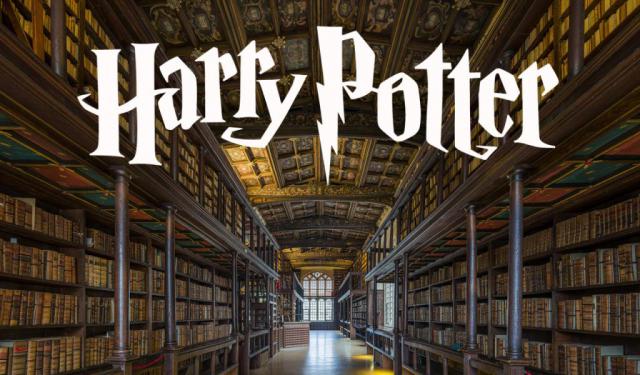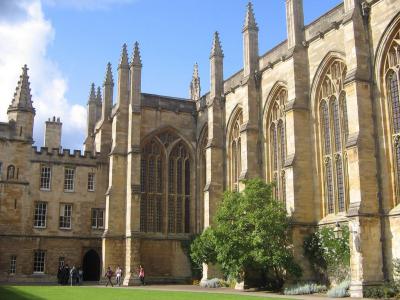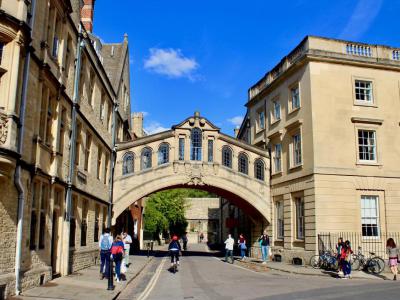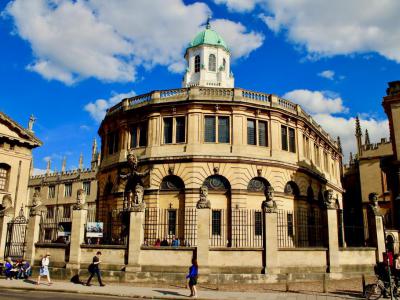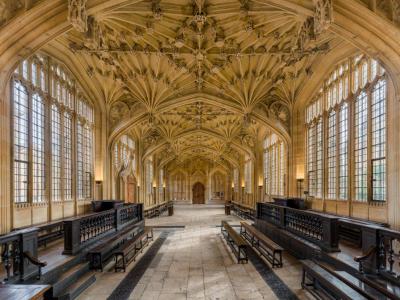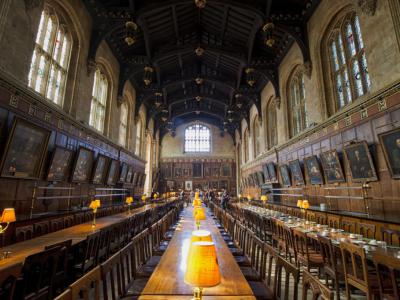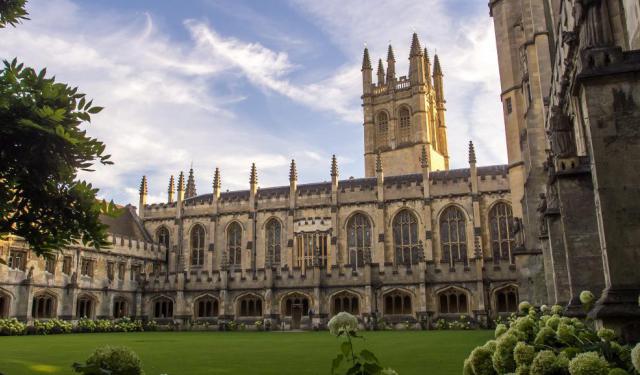Harry Potter Walk in Oxford (Self Guided), Oxford
In addition to its conventional university fame, more recently Oxford has emerged as a major filming location for the magical world of Harry Potter.
The picturesque New College served as the backdrop for several scenes in the Harry Potter movies. Its cloisters were used as the setting for Hogwarts' interiors, where characters like Harry Potter, Hermione Granger, and Ron Weasley walked through the halls and courtyards. It was also here that Harry confronted Malfoy and was then turned into a ferret by Mad-Eye Moody.
Oxford's Bridge of Sighs, in turn, inspired the filmmakers to create the bridge that connects different parts of Hogwarts in the movies, adding a touch of magic to the college's charm.
The impressive Bodleian Library, with its ancient architecture and grand reading rooms, was transformed into the Hogwarts Library for the films. It is where Hermione conducted her research and where you can feel a bit like a wizard yourself, surrounded by centuries of knowledge.
Meanwhile, the Divinity School served as the location for Professor McGonagall's classroom, where, apart from the art of Transfiguration (turning one object into another), she taught her students some dancing moves too. The place also appeared as Hogwarts Infirmary in “Harry Potter and The Philosopher's Stone”.
Lastly, the grandeur of Christ Church College's Great Hall inspired the design of Hogwarts' dining hall, where students dined, feasted, and witnessed the sorting ceremony.
If you're a Harry Potter fan or simply want to immerse yourself in the enchanting atmosphere of Oxford, these locations are a must-visit. So, pack your bags, grab your wand (or just your camera), and embark on a magical journey to explore these Harry Potter places in Oxford. Who knows, you might even discover your own wizardry in the heart of this historic city!
The picturesque New College served as the backdrop for several scenes in the Harry Potter movies. Its cloisters were used as the setting for Hogwarts' interiors, where characters like Harry Potter, Hermione Granger, and Ron Weasley walked through the halls and courtyards. It was also here that Harry confronted Malfoy and was then turned into a ferret by Mad-Eye Moody.
Oxford's Bridge of Sighs, in turn, inspired the filmmakers to create the bridge that connects different parts of Hogwarts in the movies, adding a touch of magic to the college's charm.
The impressive Bodleian Library, with its ancient architecture and grand reading rooms, was transformed into the Hogwarts Library for the films. It is where Hermione conducted her research and where you can feel a bit like a wizard yourself, surrounded by centuries of knowledge.
Meanwhile, the Divinity School served as the location for Professor McGonagall's classroom, where, apart from the art of Transfiguration (turning one object into another), she taught her students some dancing moves too. The place also appeared as Hogwarts Infirmary in “Harry Potter and The Philosopher's Stone”.
Lastly, the grandeur of Christ Church College's Great Hall inspired the design of Hogwarts' dining hall, where students dined, feasted, and witnessed the sorting ceremony.
If you're a Harry Potter fan or simply want to immerse yourself in the enchanting atmosphere of Oxford, these locations are a must-visit. So, pack your bags, grab your wand (or just your camera), and embark on a magical journey to explore these Harry Potter places in Oxford. Who knows, you might even discover your own wizardry in the heart of this historic city!
How it works: Download the app "GPSmyCity: Walks in 1K+ Cities" from Apple App Store or Google Play Store to your mobile phone or tablet. The app turns your mobile device into a personal tour guide and its built-in GPS navigation functions guide you from one tour stop to next. The app works offline, so no data plan is needed when traveling abroad.
Harry Potter Walk in Oxford Map
Guide Name: Harry Potter Walk in Oxford
Guide Location: England » Oxford (See other walking tours in Oxford)
Guide Type: Self-guided Walking Tour (Sightseeing)
# of Attractions: 5
Tour Duration: 1 Hour(s)
Travel Distance: 1.0 Km or 0.6 Miles
Author: Linda
Sight(s) Featured in This Guide:
Guide Location: England » Oxford (See other walking tours in Oxford)
Guide Type: Self-guided Walking Tour (Sightseeing)
# of Attractions: 5
Tour Duration: 1 Hour(s)
Travel Distance: 1.0 Km or 0.6 Miles
Author: Linda
Sight(s) Featured in This Guide:
- New College
- Bridge of Sighs
- Bodleian Library
- Divinity School
- Christ Church College
1) New College (must see)
New College, one of the prestigious constituent colleges of the University of Oxford in the United Kingdom, stands out for its rich history and significant contributions to academia and culture. Founded in 1379 by William of Wykeham, the Bishop of Winchester, it was originally named "Saint Mary College of Winchester in Oxenford." Wykeham established New College alongside Winchester College, which served as its feeder school. Remarkably, New College was among the first in the university to admit and tutor undergraduate students.
Despite its misleading name, New College is one of Oxford's oldest colleges. In 2017, it achieved the top rank in the Norrington Table, which assesses the performance of Oxford undergraduates in final exams. Historically, it consistently ranks high, with a remarkable 3rd highest average in the Norrington Table over the past decade.
Reflecting societal changes, New College welcomed its first mixed-sex cohort in 1979, transitioning from a six-century tradition of being a male-only institution.
New College is also celebrated for its choral tradition, being one of the main choral foundations of the University of Oxford. Its choir is considered one of the world's leading choirs, a testament to which is its extensive discography and the two Gramophone Awards it has won.
New College is architecturally rich with historical significance. Originally built in the "perpendicular style," it has seen various additions and changes over the centuries. The Great Quad, initially constructed with attics in the sixteenth century, got a proper third storey in 1674. The oval turf at the center of the quad dates back to the eighteenth century. Many college buildings are known for their unique architectural and historical value. 'New Buildings' along Holywell Street showcase different architectural styles, including High Victorian and late Victorian by George Gilbert Scott and Basil Champneys, respectively.
***Harry Potter Walk***
The New College Cloisters appear in Harry Potter and the Goblet of Fire a good number of times – many of the corridor scenes within the film are shot here, including that in which Harry has to push through all the Gryffyndor students wearing Potter stinks badges to go and have a word with Cedric.
The New College Courtyard also served as a filming location for Harry Potter and the Goblet of Fire – the scene in which Harry tips off Cedric about the dragons which they will be battling in the first of the trials in the Triwizard Tournament. In the same movie, Harry comes face to face with Malfoy, who is sitting on a gigantic oak tree and where he is then turned into a ferret by Mad-Eye Moody. This particular tree is found in the New College Cloisters.
If you come to explore all things Harry Potter at Oxford during the colder period (October through March), then the entry to New College is free. However, if you go during the warmer months (March to October), you will need to buy a ticket.
Despite its misleading name, New College is one of Oxford's oldest colleges. In 2017, it achieved the top rank in the Norrington Table, which assesses the performance of Oxford undergraduates in final exams. Historically, it consistently ranks high, with a remarkable 3rd highest average in the Norrington Table over the past decade.
Reflecting societal changes, New College welcomed its first mixed-sex cohort in 1979, transitioning from a six-century tradition of being a male-only institution.
New College is also celebrated for its choral tradition, being one of the main choral foundations of the University of Oxford. Its choir is considered one of the world's leading choirs, a testament to which is its extensive discography and the two Gramophone Awards it has won.
New College is architecturally rich with historical significance. Originally built in the "perpendicular style," it has seen various additions and changes over the centuries. The Great Quad, initially constructed with attics in the sixteenth century, got a proper third storey in 1674. The oval turf at the center of the quad dates back to the eighteenth century. Many college buildings are known for their unique architectural and historical value. 'New Buildings' along Holywell Street showcase different architectural styles, including High Victorian and late Victorian by George Gilbert Scott and Basil Champneys, respectively.
***Harry Potter Walk***
The New College Cloisters appear in Harry Potter and the Goblet of Fire a good number of times – many of the corridor scenes within the film are shot here, including that in which Harry has to push through all the Gryffyndor students wearing Potter stinks badges to go and have a word with Cedric.
The New College Courtyard also served as a filming location for Harry Potter and the Goblet of Fire – the scene in which Harry tips off Cedric about the dragons which they will be battling in the first of the trials in the Triwizard Tournament. In the same movie, Harry comes face to face with Malfoy, who is sitting on a gigantic oak tree and where he is then turned into a ferret by Mad-Eye Moody. This particular tree is found in the New College Cloisters.
If you come to explore all things Harry Potter at Oxford during the colder period (October through March), then the entry to New College is free. However, if you go during the warmer months (March to October), you will need to buy a ticket.
2) Bridge of Sighs (must see)
Unfortunately, if you are not a student of Hertford College, you won’t be able to cross the Bridge of Sighs, but you can certainly admire it from street level and add a photo of it to your collection of Oxford’s marvellous structures.
The real name of the bridge is the Hertford Bridge and it was built in 1914 by Sir Thomas Jackson. It took its popular name from the fact that it is supposed to look just like the bridge of the same name in Venice. Actually, it resembles the Rialto Bridge more than anything else, but the Bridge of Sighs sounds more romantic.
The bridge is a fine example of the Quadrature of the Parabola, developed by Archimedes in the 3rd century BC – a rather difficult geometrical concept in that the area of a parabolic segment is 4/3 of a certain inscribed triangle. It all comes down to the triangle (top) of the bridge being supported by the arch (parabola) because they are of the same base length and height.
Leaving the Maths lesson behind, the bridge is covered and glass panelled and links the college’s Old Quad with the New Quad. According to popular legend, the college once closed the bridge to overweight students, forcing them to get some exercise by taking the long route from one building to another.
***Harry Potter Walk***
Conveniently easy to spot behind Oxford’s very own Bridge of Sighs, the ancient (almost 200-year-old) giant Oak Tree, featured during a duel between Harry Potter and Draco Malfoy in Harry Potter and the Goblet of Fire, can be seen in New College Cloisters. And while the cloisters themselves are closed to the public, a photo of the tree can still be snapped from the roadside!
The real name of the bridge is the Hertford Bridge and it was built in 1914 by Sir Thomas Jackson. It took its popular name from the fact that it is supposed to look just like the bridge of the same name in Venice. Actually, it resembles the Rialto Bridge more than anything else, but the Bridge of Sighs sounds more romantic.
The bridge is a fine example of the Quadrature of the Parabola, developed by Archimedes in the 3rd century BC – a rather difficult geometrical concept in that the area of a parabolic segment is 4/3 of a certain inscribed triangle. It all comes down to the triangle (top) of the bridge being supported by the arch (parabola) because they are of the same base length and height.
Leaving the Maths lesson behind, the bridge is covered and glass panelled and links the college’s Old Quad with the New Quad. According to popular legend, the college once closed the bridge to overweight students, forcing them to get some exercise by taking the long route from one building to another.
***Harry Potter Walk***
Conveniently easy to spot behind Oxford’s very own Bridge of Sighs, the ancient (almost 200-year-old) giant Oak Tree, featured during a duel between Harry Potter and Draco Malfoy in Harry Potter and the Goblet of Fire, can be seen in New College Cloisters. And while the cloisters themselves are closed to the public, a photo of the tree can still be snapped from the roadside!
3) Bodleian Library (must see)
Bodleian Library is the main research library of Oxford University, and if you are not a student, you can visit it on a guided tour which should be booked in advance.
The Bodleian is one of the oldest reference libraries in Europe and one of the six legal deposit libraries in the United Kingdom, which means that a copy of every book published in the UK and Ireland is required by law to be deposited here.
The 1st library was founded by Thomas Cobham, the Bishop of Worcester, in the 14th century. It was a chained library – the books were chained to the shelves to stop people pinching them. In 1437, after the Duke of Gloucester donated a vast number of manuscripts, the building proved too small, so Duke Humphrey’s Library was built at Divinity School.
Over the years, the library fell into disuse until 1598 when a Fellow of Merton College, Thomas Bodley, had the place renovated and enlarged to receive his collection of books. It reopened in 1602 and took its present-day name. It was also Bodley who made an agreement with the Stationer’s Company in 1610 to put a copy of each of their books in the library. This agreement became the Deposit Law in the 19th century.
The library expanded in 1612 and 1637 and grew popular with Fellows to donate or bequeath their collections. The New Library was built in 1937 and today a tunnel under Broad Street connects the Old and the New Bodleian.
The library holds a staggering 11 million books and other reading matter, 117 miles of shelves and 400 staff members. Among the ancient manuscripts here is a copy of the Magna Charta and the Song of Roland. It also houses one of the last copies of the Guttenberg Bible.
***Harry Potter Tour***
Hidden away in the Bodleian Library, the Duke Humfrey’s reading room revels in a magical atmosphere. Boasting imposing high walls and an intricately painted ceiling, even the smallest of Harry Potter fans will fail to ignore this eye-catching beauty. Presented as the main Hogwarts Library in the film series, it is most memorable for the scene in The Philosopher’s Stone, when Harry uses his Cloak of Invisibility to sneak into the restricted section of the library. We see Harry creeping around here before he is given away by a screaming book.
The Bodleian is one of the oldest reference libraries in Europe and one of the six legal deposit libraries in the United Kingdom, which means that a copy of every book published in the UK and Ireland is required by law to be deposited here.
The 1st library was founded by Thomas Cobham, the Bishop of Worcester, in the 14th century. It was a chained library – the books were chained to the shelves to stop people pinching them. In 1437, after the Duke of Gloucester donated a vast number of manuscripts, the building proved too small, so Duke Humphrey’s Library was built at Divinity School.
Over the years, the library fell into disuse until 1598 when a Fellow of Merton College, Thomas Bodley, had the place renovated and enlarged to receive his collection of books. It reopened in 1602 and took its present-day name. It was also Bodley who made an agreement with the Stationer’s Company in 1610 to put a copy of each of their books in the library. This agreement became the Deposit Law in the 19th century.
The library expanded in 1612 and 1637 and grew popular with Fellows to donate or bequeath their collections. The New Library was built in 1937 and today a tunnel under Broad Street connects the Old and the New Bodleian.
The library holds a staggering 11 million books and other reading matter, 117 miles of shelves and 400 staff members. Among the ancient manuscripts here is a copy of the Magna Charta and the Song of Roland. It also houses one of the last copies of the Guttenberg Bible.
***Harry Potter Tour***
Hidden away in the Bodleian Library, the Duke Humfrey’s reading room revels in a magical atmosphere. Boasting imposing high walls and an intricately painted ceiling, even the smallest of Harry Potter fans will fail to ignore this eye-catching beauty. Presented as the main Hogwarts Library in the film series, it is most memorable for the scene in The Philosopher’s Stone, when Harry uses his Cloak of Invisibility to sneak into the restricted section of the library. We see Harry creeping around here before he is given away by a screaming book.
4) Divinity School
The Divinity School, an impressive example of Medieval architecture, is renowned for its elaborate ceiling designs and tall, spacious windows. It is connected to the Bodleian Library and is located across from the Sheldonian Theatre, which is utilized by students for their matriculation and graduation ceremonies.
Built between 1427 and 1483, this building holds the distinction of being the oldest surviving structure specifically designed for university-related activities. It was originally intended for lectures, oral examinations, and theological discussions. Although it no longer serves these functions, it is noteworthy that Oxford University still offers degree programs in Theology and Religion through its Faculty of Theology and Religion.
The ceiling of the Divinity School showcases intricate lierne vaulting adorned with 455 decorative elements called bosses. This remarkable architectural design was created by William Orchard in the 1480s.
The location was used in the filming of the first four Harry Potter movies, where it served as the setting for the Hogwarts Hospital Wing. Fans of the early films will recognize it as the place where Harry wakes up at the end of "The Philosopher’s Stone" after his initial encounter with Voldemort.
Other scenes from the series include "The Prisoner of Azkaban," where Harry and Hermione use the time turner to rescue Sirius Black and Buckbeak, and "The Goblet of Fire," where Professor McGonagall attempts to teach Ron Weasley some dance moves before the Yule Ball.
Built between 1427 and 1483, this building holds the distinction of being the oldest surviving structure specifically designed for university-related activities. It was originally intended for lectures, oral examinations, and theological discussions. Although it no longer serves these functions, it is noteworthy that Oxford University still offers degree programs in Theology and Religion through its Faculty of Theology and Religion.
The ceiling of the Divinity School showcases intricate lierne vaulting adorned with 455 decorative elements called bosses. This remarkable architectural design was created by William Orchard in the 1480s.
The location was used in the filming of the first four Harry Potter movies, where it served as the setting for the Hogwarts Hospital Wing. Fans of the early films will recognize it as the place where Harry wakes up at the end of "The Philosopher’s Stone" after his initial encounter with Voldemort.
Other scenes from the series include "The Prisoner of Azkaban," where Harry and Hermione use the time turner to rescue Sirius Black and Buckbeak, and "The Goblet of Fire," where Professor McGonagall attempts to teach Ron Weasley some dance moves before the Yule Ball.
5) Christ Church College (must see)
Founded in 1546 by King Henry VIII, Christ Church stands as one of the University of Oxford's largest and most affluent colleges. Noteworthy for its distinctive architecture, the college boasts several significant structures, including Tom Tower, designed by Sir Christopher Wren, Tom Quad, Oxford's largest quadrangle, and the Great Dining Hall, which also served as the gathering place for King Charles I's parliament during the English Civil War.
Christ Church boasts an impressive list of alumni, counting thirteen British prime ministers, more than any other Oxbridge college, as well as King Edward VII, King William II of the Netherlands, seventeen Archbishops, and the renowned author Lewis Carroll, known for penning "Alice in Wonderland."
Christ Church houses one of the UK's most significant private collections of drawings, featuring artworks by renowned artists such as Leonardo da Vinci, Raphael, and Michelangelo. This collection consists of approximately 300 paintings and 2,000 drawings, and a curated selection of these pieces is accessible to the general public at the specially designed Christ Church Picture Gallery. Most of these artworks were generously donated by a former college member, General John Guise (16823-1765), which paved the way for the establishment of the first-ever public art gallery in Britain.
The college's buildings and grounds have featured prominently in literary works such as Evelyn Waugh's "Brideshead Revisited" and in a minor capacity in Lewis Carroll's "Alice's Adventures in Wonderland." More recently, it has served as a backdrop for the film adaptations of J. K. Rowling's "Harry Potter" series and Philip Pullman's novel "Northern Lights" (released in the United States as "The Golden Compass"). These appearances have catapulted Christ Church to its status as the most frequented Oxford college by tourists, attracting nearly half a million visitors each year.
***Harry Potter Walk***
Christ Church Dining Hall
Contrary to belief, no filming actually took place inside the famous Christ Church Dining Hall. Still, it did provide an immense inspiration for Hogwart’s very own Great Hall. Founded in the time of King Henry VII and being alma mater to thirteen British Prime Ministers, it's no wonder that the filmmakers opted to replicate this historical location at their own Warner Bros. studios. Matchingly magnificent, both the Christ Church Dining Hall and its studio copy are worth visiting, even if only to compare, all the same.
Bodley Tower Staircase
Probably one of the most famous filming spots, the grand stone staircase, located inside Bodley Tower at Christ Church College, is a prominent feature in the first two Harry Potter movies. Among the several memorable scenes filmed here are Harry’s first day at Hogwarts; a flashback sequence between Tom Riddle and Dumbledore; and a scene near the end of the first film where Harry is reunited with Ron and Hermione after being released from Hogwarts Infirmary – the one many Potterheads, no doubt, hold dear to their hearts.
Christ Church Cloisters
The Cloisters played a starring role in Harry Potter and the Philosopher’s Stone, as Hogwarts Hallways.
Another notable scene associated with the hallways is that when Harry has just been made seeker for the Gryffindor quidditch team. In it, Hermione tells him that being a seeker is “in his blood,” upon which she goes on to show him a display case containing a quidditch trophy with his father’s name inscription.
Christ Church boasts an impressive list of alumni, counting thirteen British prime ministers, more than any other Oxbridge college, as well as King Edward VII, King William II of the Netherlands, seventeen Archbishops, and the renowned author Lewis Carroll, known for penning "Alice in Wonderland."
Christ Church houses one of the UK's most significant private collections of drawings, featuring artworks by renowned artists such as Leonardo da Vinci, Raphael, and Michelangelo. This collection consists of approximately 300 paintings and 2,000 drawings, and a curated selection of these pieces is accessible to the general public at the specially designed Christ Church Picture Gallery. Most of these artworks were generously donated by a former college member, General John Guise (16823-1765), which paved the way for the establishment of the first-ever public art gallery in Britain.
The college's buildings and grounds have featured prominently in literary works such as Evelyn Waugh's "Brideshead Revisited" and in a minor capacity in Lewis Carroll's "Alice's Adventures in Wonderland." More recently, it has served as a backdrop for the film adaptations of J. K. Rowling's "Harry Potter" series and Philip Pullman's novel "Northern Lights" (released in the United States as "The Golden Compass"). These appearances have catapulted Christ Church to its status as the most frequented Oxford college by tourists, attracting nearly half a million visitors each year.
***Harry Potter Walk***
Christ Church Dining Hall
Contrary to belief, no filming actually took place inside the famous Christ Church Dining Hall. Still, it did provide an immense inspiration for Hogwart’s very own Great Hall. Founded in the time of King Henry VII and being alma mater to thirteen British Prime Ministers, it's no wonder that the filmmakers opted to replicate this historical location at their own Warner Bros. studios. Matchingly magnificent, both the Christ Church Dining Hall and its studio copy are worth visiting, even if only to compare, all the same.
Bodley Tower Staircase
Probably one of the most famous filming spots, the grand stone staircase, located inside Bodley Tower at Christ Church College, is a prominent feature in the first two Harry Potter movies. Among the several memorable scenes filmed here are Harry’s first day at Hogwarts; a flashback sequence between Tom Riddle and Dumbledore; and a scene near the end of the first film where Harry is reunited with Ron and Hermione after being released from Hogwarts Infirmary – the one many Potterheads, no doubt, hold dear to their hearts.
Christ Church Cloisters
The Cloisters played a starring role in Harry Potter and the Philosopher’s Stone, as Hogwarts Hallways.
Another notable scene associated with the hallways is that when Harry has just been made seeker for the Gryffindor quidditch team. In it, Hermione tells him that being a seeker is “in his blood,” upon which she goes on to show him a display case containing a quidditch trophy with his father’s name inscription.
Walking Tours in Oxford, England
Create Your Own Walk in Oxford
Creating your own self-guided walk in Oxford is easy and fun. Choose the city attractions that you want to see and a walk route map will be created just for you. You can even set your hotel as the start point of the walk.
Oxford Introduction Walking Tour
Oxford, a city in central England, has captivated the minds of scholars and travelers for centuries. The name "Oxford" originates from the Old English "Oxenaford," which means "shallow crossing of the oxen." It harks back to the early days (circa 900 AD) when a small settlement established by the Anglo-Saxons served as an important crossing point on the upper reaches... view more
Tour Duration: 2 Hour(s)
Travel Distance: 3.5 Km or 2.2 Miles
Tour Duration: 2 Hour(s)
Travel Distance: 3.5 Km or 2.2 Miles
Colleges of Oxford University
The University of Oxford is the oldest educational institution in England and one of the best in the world. Alma mater for thousands of the most influential people on the planet, it is also a major attraction for architecture and history buffs.
The university represents a "federation" incorporating 38 self-governing colleges and six permanent private halls. Let's take a closer... view more
Tour Duration: 1 Hour(s)
Travel Distance: 1.5 Km or 0.9 Miles
The university represents a "federation" incorporating 38 self-governing colleges and six permanent private halls. Let's take a closer... view more
Tour Duration: 1 Hour(s)
Travel Distance: 1.5 Km or 0.9 Miles
The Most Popular Cities
/ view all
